MGT723 Research Project: Carbon Emission and Stakeholders
VerifiedAdded on 2023/06/07
|15
|3297
|149
Report
AI Summary
This research proposal, submitted for MGT723, delves into contemporary issues in accounting, specifically focusing on carbon emissions and their relation to stakeholder theory within the context of Australian manufacturing industries. The study begins with an introduction that highlights the increasing concern surrounding carbon emissions and the role of companies in contributing to greenhouse gases, setting the stage for an investigation into the impact of stakeholder pressure on environmental management. The practical motivation underscores the importance of carbon emission reduction for accountants, regulators, and the public, emphasizing the adverse effects of climate change and the implementation of environmental strategies. The theoretical motivation outlines the research's contribution to the existing literature by addressing gaps, testing theories, and reconciling conflicting outcomes. The literature review introduces stakeholder theory and its application to carbon emission reduction. The research employs a conceptual model to analyze the relationship between physical climate change, carbon emissions, and industry type, with hypotheses designed to assess these relationships. The research is designed to evaluate how stakeholder engagement and concerns influence carbon emission levels within Australian manufacturing companies, providing valuable insights into environmental accounting practices.
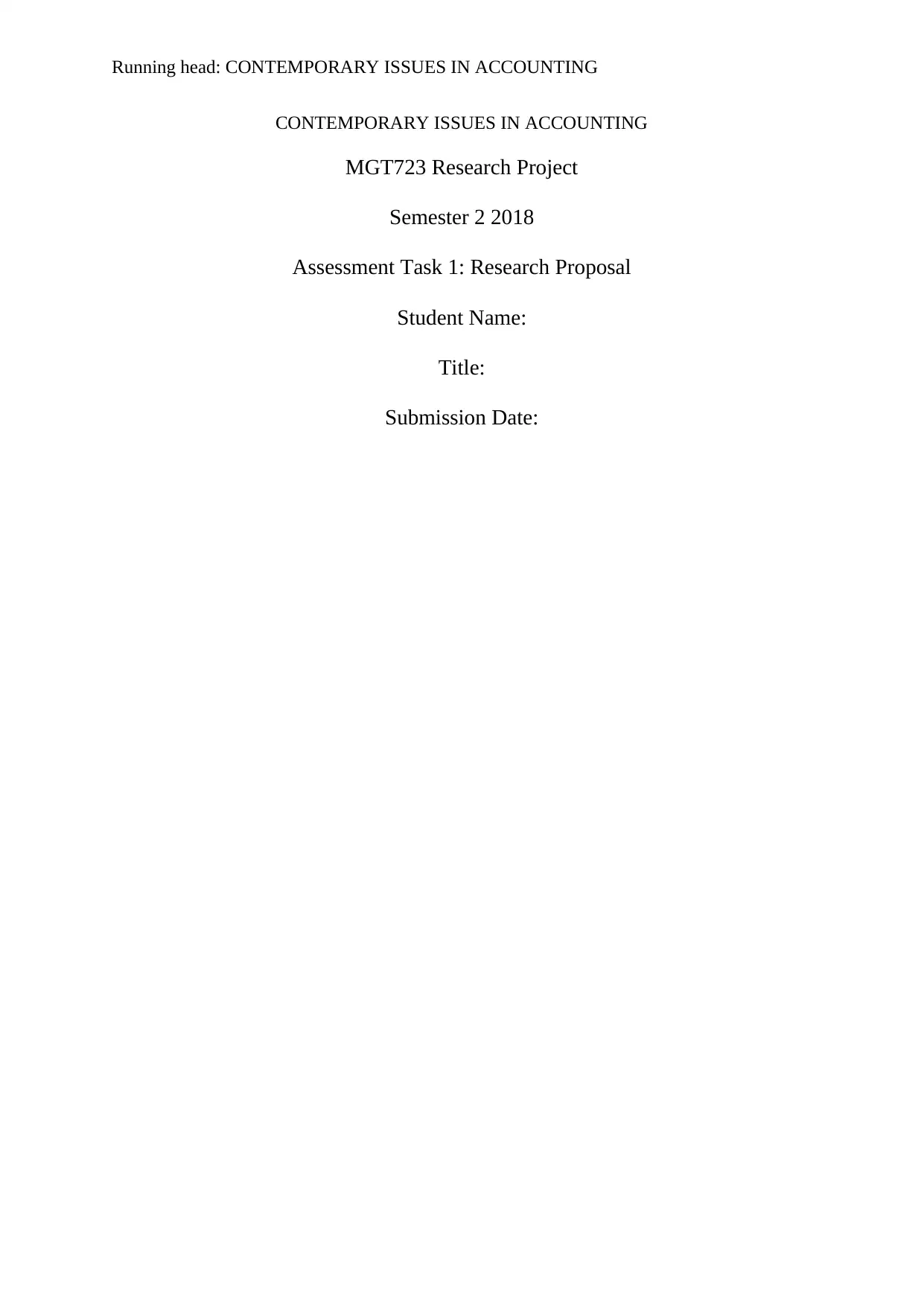
Running head: CONTEMPORARY ISSUES IN ACCOUNTING
CONTEMPORARY ISSUES IN ACCOUNTING
MGT723 Research Project
Semester 2 2018
Assessment Task 1: Research Proposal
Student Name:
Title:
Submission Date:
CONTEMPORARY ISSUES IN ACCOUNTING
MGT723 Research Project
Semester 2 2018
Assessment Task 1: Research Proposal
Student Name:
Title:
Submission Date:
Paraphrase This Document
Need a fresh take? Get an instant paraphrase of this document with our AI Paraphraser
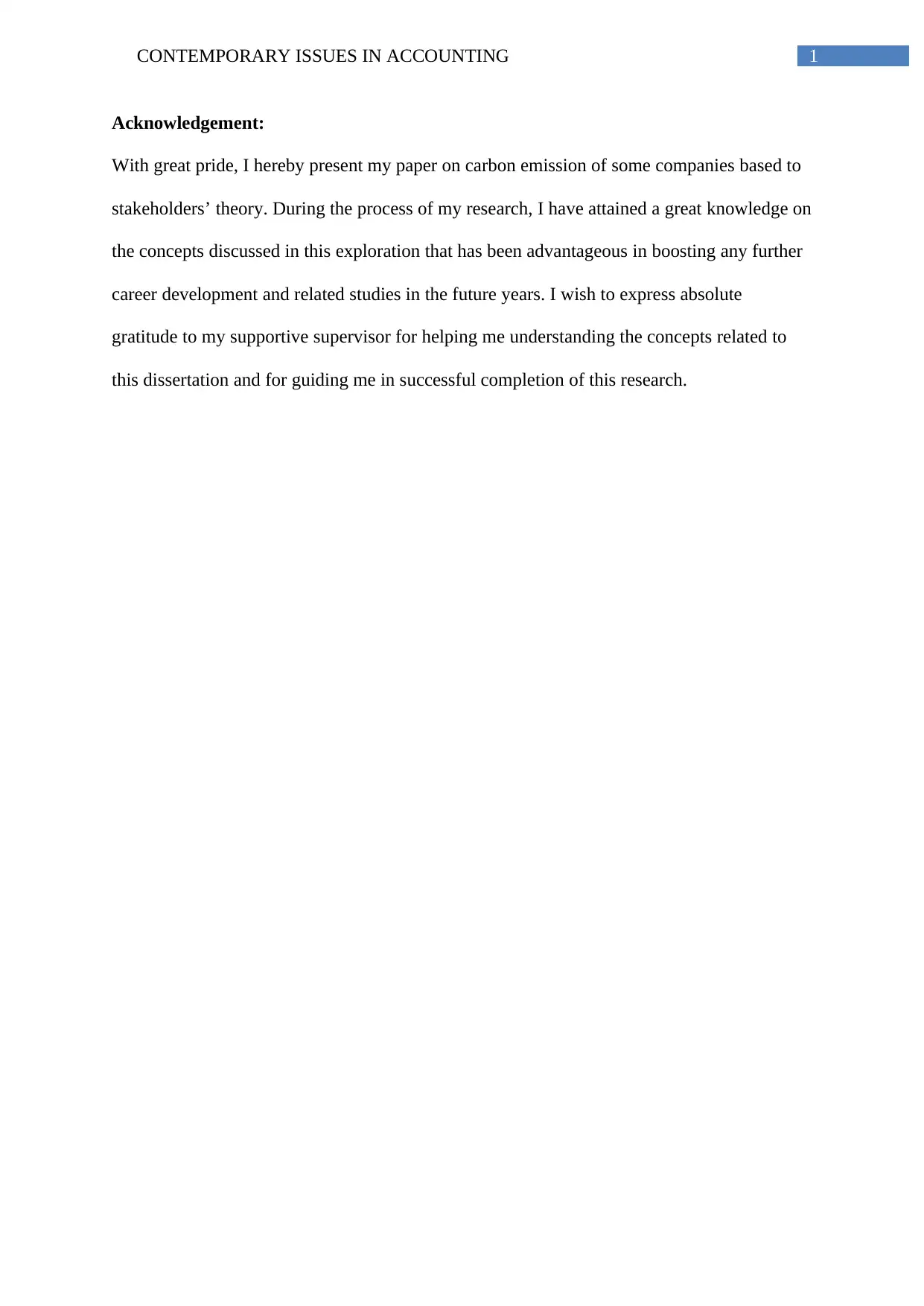
1CONTEMPORARY ISSUES IN ACCOUNTING
Acknowledgement:
With great pride, I hereby present my paper on carbon emission of some companies based to
stakeholders’ theory. During the process of my research, I have attained a great knowledge on
the concepts discussed in this exploration that has been advantageous in boosting any further
career development and related studies in the future years. I wish to express absolute
gratitude to my supportive supervisor for helping me understanding the concepts related to
this dissertation and for guiding me in successful completion of this research.
Acknowledgement:
With great pride, I hereby present my paper on carbon emission of some companies based to
stakeholders’ theory. During the process of my research, I have attained a great knowledge on
the concepts discussed in this exploration that has been advantageous in boosting any further
career development and related studies in the future years. I wish to express absolute
gratitude to my supportive supervisor for helping me understanding the concepts related to
this dissertation and for guiding me in successful completion of this research.
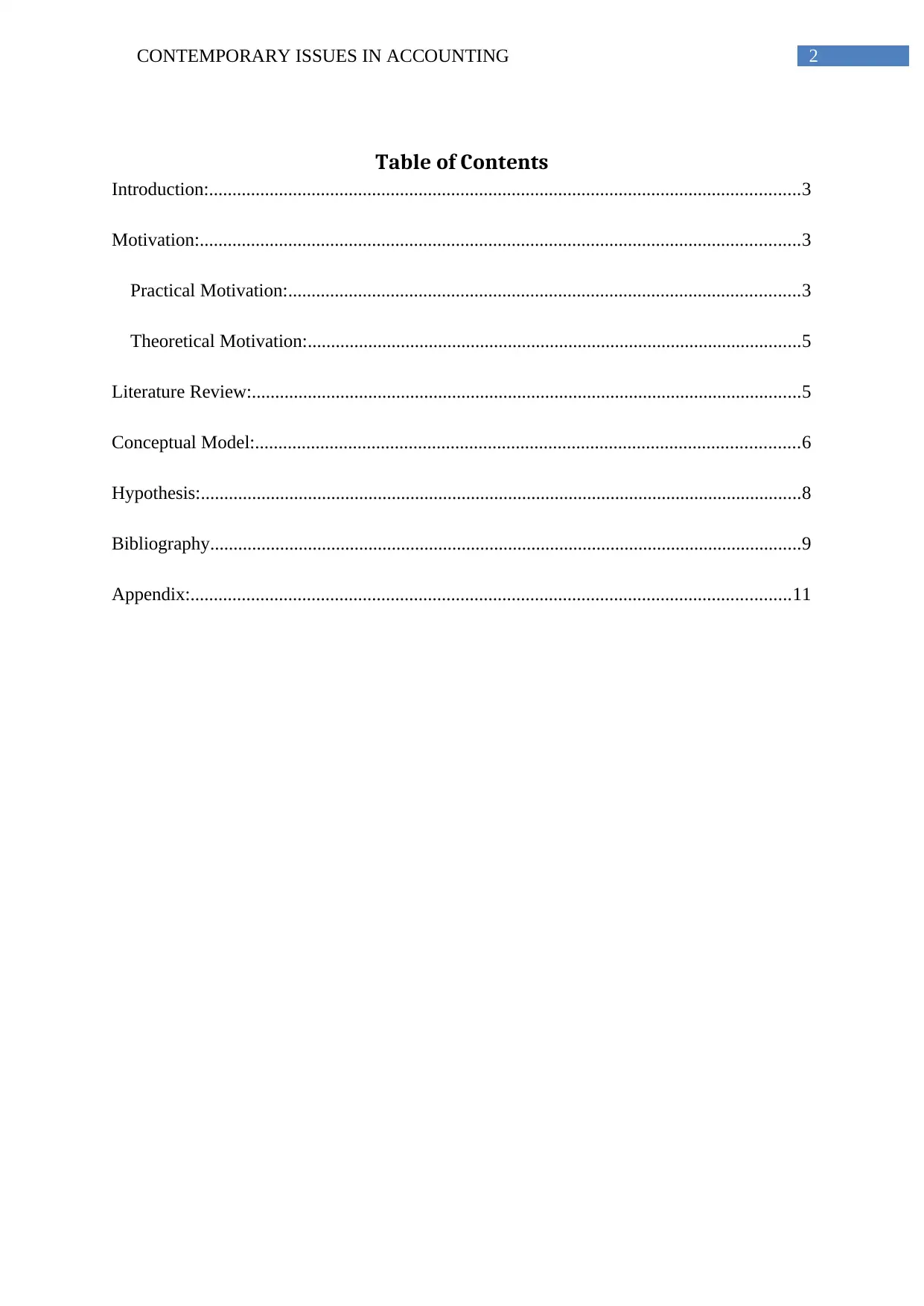
2CONTEMPORARY ISSUES IN ACCOUNTING
Table of Contents
Introduction:...............................................................................................................................3
Motivation:.................................................................................................................................3
Practical Motivation:..............................................................................................................3
Theoretical Motivation:..........................................................................................................5
Literature Review:......................................................................................................................5
Conceptual Model:.....................................................................................................................6
Hypothesis:.................................................................................................................................8
Bibliography...............................................................................................................................9
Appendix:.................................................................................................................................11
Table of Contents
Introduction:...............................................................................................................................3
Motivation:.................................................................................................................................3
Practical Motivation:..............................................................................................................3
Theoretical Motivation:..........................................................................................................5
Literature Review:......................................................................................................................5
Conceptual Model:.....................................................................................................................6
Hypothesis:.................................................................................................................................8
Bibliography...............................................................................................................................9
Appendix:.................................................................................................................................11
⊘ This is a preview!⊘
Do you want full access?
Subscribe today to unlock all pages.

Trusted by 1+ million students worldwide
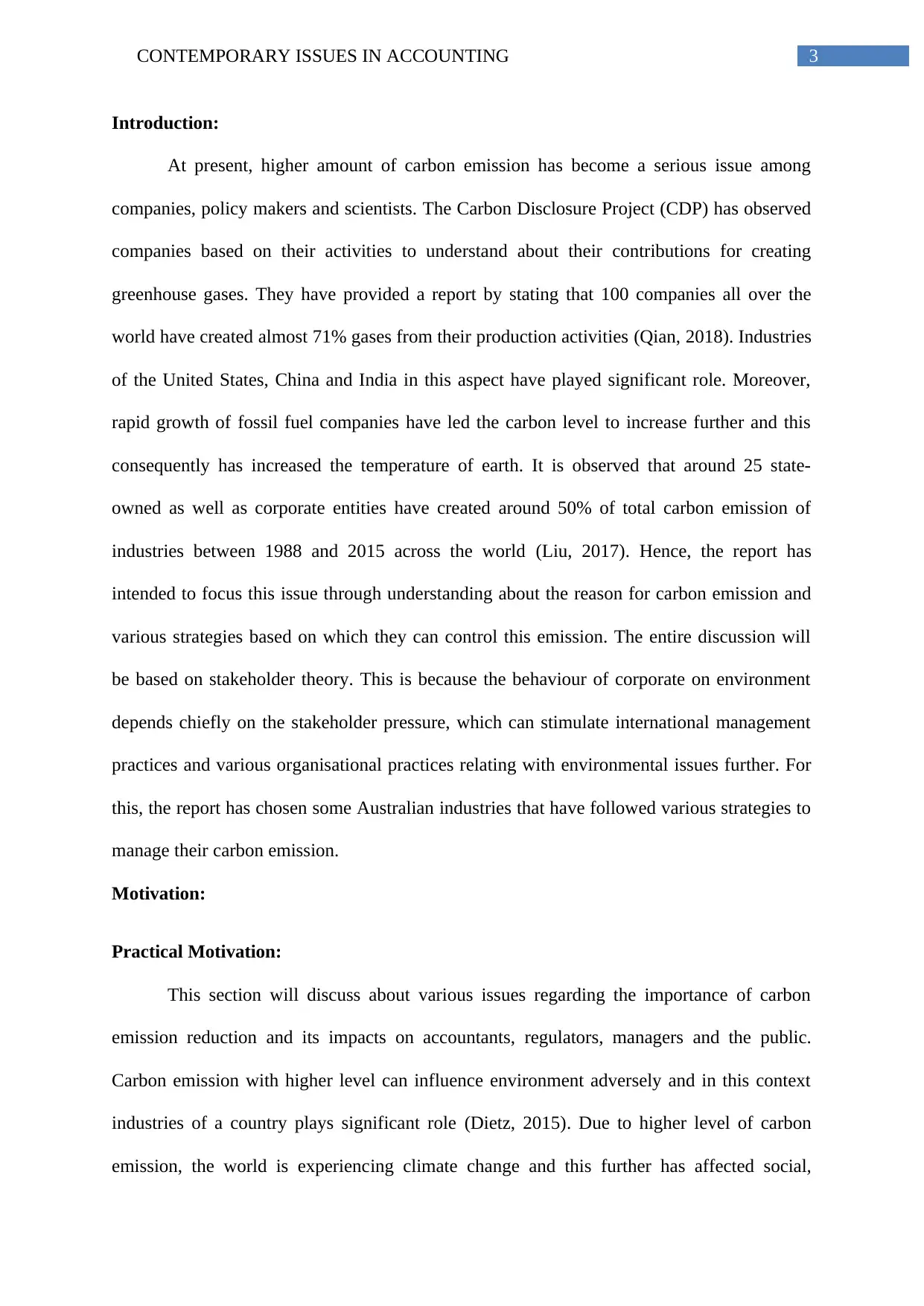
3CONTEMPORARY ISSUES IN ACCOUNTING
Introduction:
At present, higher amount of carbon emission has become a serious issue among
companies, policy makers and scientists. The Carbon Disclosure Project (CDP) has observed
companies based on their activities to understand about their contributions for creating
greenhouse gases. They have provided a report by stating that 100 companies all over the
world have created almost 71% gases from their production activities (Qian, 2018). Industries
of the United States, China and India in this aspect have played significant role. Moreover,
rapid growth of fossil fuel companies have led the carbon level to increase further and this
consequently has increased the temperature of earth. It is observed that around 25 state-
owned as well as corporate entities have created around 50% of total carbon emission of
industries between 1988 and 2015 across the world (Liu, 2017). Hence, the report has
intended to focus this issue through understanding about the reason for carbon emission and
various strategies based on which they can control this emission. The entire discussion will
be based on stakeholder theory. This is because the behaviour of corporate on environment
depends chiefly on the stakeholder pressure, which can stimulate international management
practices and various organisational practices relating with environmental issues further. For
this, the report has chosen some Australian industries that have followed various strategies to
manage their carbon emission.
Motivation:
Practical Motivation:
This section will discuss about various issues regarding the importance of carbon
emission reduction and its impacts on accountants, regulators, managers and the public.
Carbon emission with higher level can influence environment adversely and in this context
industries of a country plays significant role (Dietz, 2015). Due to higher level of carbon
emission, the world is experiencing climate change and this further has affected social,
Introduction:
At present, higher amount of carbon emission has become a serious issue among
companies, policy makers and scientists. The Carbon Disclosure Project (CDP) has observed
companies based on their activities to understand about their contributions for creating
greenhouse gases. They have provided a report by stating that 100 companies all over the
world have created almost 71% gases from their production activities (Qian, 2018). Industries
of the United States, China and India in this aspect have played significant role. Moreover,
rapid growth of fossil fuel companies have led the carbon level to increase further and this
consequently has increased the temperature of earth. It is observed that around 25 state-
owned as well as corporate entities have created around 50% of total carbon emission of
industries between 1988 and 2015 across the world (Liu, 2017). Hence, the report has
intended to focus this issue through understanding about the reason for carbon emission and
various strategies based on which they can control this emission. The entire discussion will
be based on stakeholder theory. This is because the behaviour of corporate on environment
depends chiefly on the stakeholder pressure, which can stimulate international management
practices and various organisational practices relating with environmental issues further. For
this, the report has chosen some Australian industries that have followed various strategies to
manage their carbon emission.
Motivation:
Practical Motivation:
This section will discuss about various issues regarding the importance of carbon
emission reduction and its impacts on accountants, regulators, managers and the public.
Carbon emission with higher level can influence environment adversely and in this context
industries of a country plays significant role (Dietz, 2015). Due to higher level of carbon
emission, the world is experiencing climate change and this further has affected social,
Paraphrase This Document
Need a fresh take? Get an instant paraphrase of this document with our AI Paraphraser
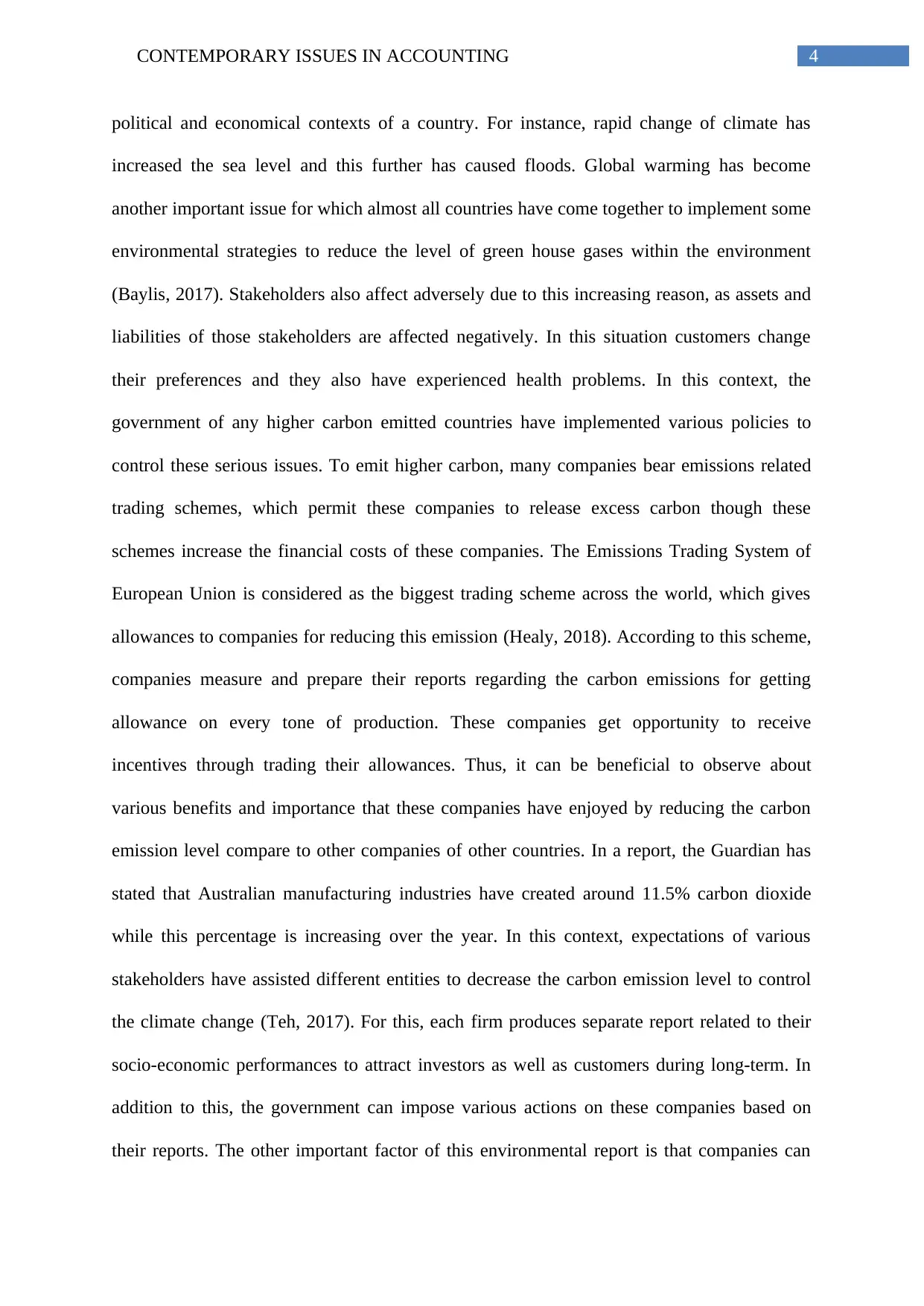
4CONTEMPORARY ISSUES IN ACCOUNTING
political and economical contexts of a country. For instance, rapid change of climate has
increased the sea level and this further has caused floods. Global warming has become
another important issue for which almost all countries have come together to implement some
environmental strategies to reduce the level of green house gases within the environment
(Baylis, 2017). Stakeholders also affect adversely due to this increasing reason, as assets and
liabilities of those stakeholders are affected negatively. In this situation customers change
their preferences and they also have experienced health problems. In this context, the
government of any higher carbon emitted countries have implemented various policies to
control these serious issues. To emit higher carbon, many companies bear emissions related
trading schemes, which permit these companies to release excess carbon though these
schemes increase the financial costs of these companies. The Emissions Trading System of
European Union is considered as the biggest trading scheme across the world, which gives
allowances to companies for reducing this emission (Healy, 2018). According to this scheme,
companies measure and prepare their reports regarding the carbon emissions for getting
allowance on every tone of production. These companies get opportunity to receive
incentives through trading their allowances. Thus, it can be beneficial to observe about
various benefits and importance that these companies have enjoyed by reducing the carbon
emission level compare to other companies of other countries. In a report, the Guardian has
stated that Australian manufacturing industries have created around 11.5% carbon dioxide
while this percentage is increasing over the year. In this context, expectations of various
stakeholders have assisted different entities to decrease the carbon emission level to control
the climate change (Teh, 2017). For this, each firm produces separate report related to their
socio-economic performances to attract investors as well as customers during long-term. In
addition to this, the government can impose various actions on these companies based on
their reports. The other important factor of this environmental report is that companies can
political and economical contexts of a country. For instance, rapid change of climate has
increased the sea level and this further has caused floods. Global warming has become
another important issue for which almost all countries have come together to implement some
environmental strategies to reduce the level of green house gases within the environment
(Baylis, 2017). Stakeholders also affect adversely due to this increasing reason, as assets and
liabilities of those stakeholders are affected negatively. In this situation customers change
their preferences and they also have experienced health problems. In this context, the
government of any higher carbon emitted countries have implemented various policies to
control these serious issues. To emit higher carbon, many companies bear emissions related
trading schemes, which permit these companies to release excess carbon though these
schemes increase the financial costs of these companies. The Emissions Trading System of
European Union is considered as the biggest trading scheme across the world, which gives
allowances to companies for reducing this emission (Healy, 2018). According to this scheme,
companies measure and prepare their reports regarding the carbon emissions for getting
allowance on every tone of production. These companies get opportunity to receive
incentives through trading their allowances. Thus, it can be beneficial to observe about
various benefits and importance that these companies have enjoyed by reducing the carbon
emission level compare to other companies of other countries. In a report, the Guardian has
stated that Australian manufacturing industries have created around 11.5% carbon dioxide
while this percentage is increasing over the year. In this context, expectations of various
stakeholders have assisted different entities to decrease the carbon emission level to control
the climate change (Teh, 2017). For this, each firm produces separate report related to their
socio-economic performances to attract investors as well as customers during long-term. In
addition to this, the government can impose various actions on these companies based on
their reports. The other important factor of this environmental report is that companies can
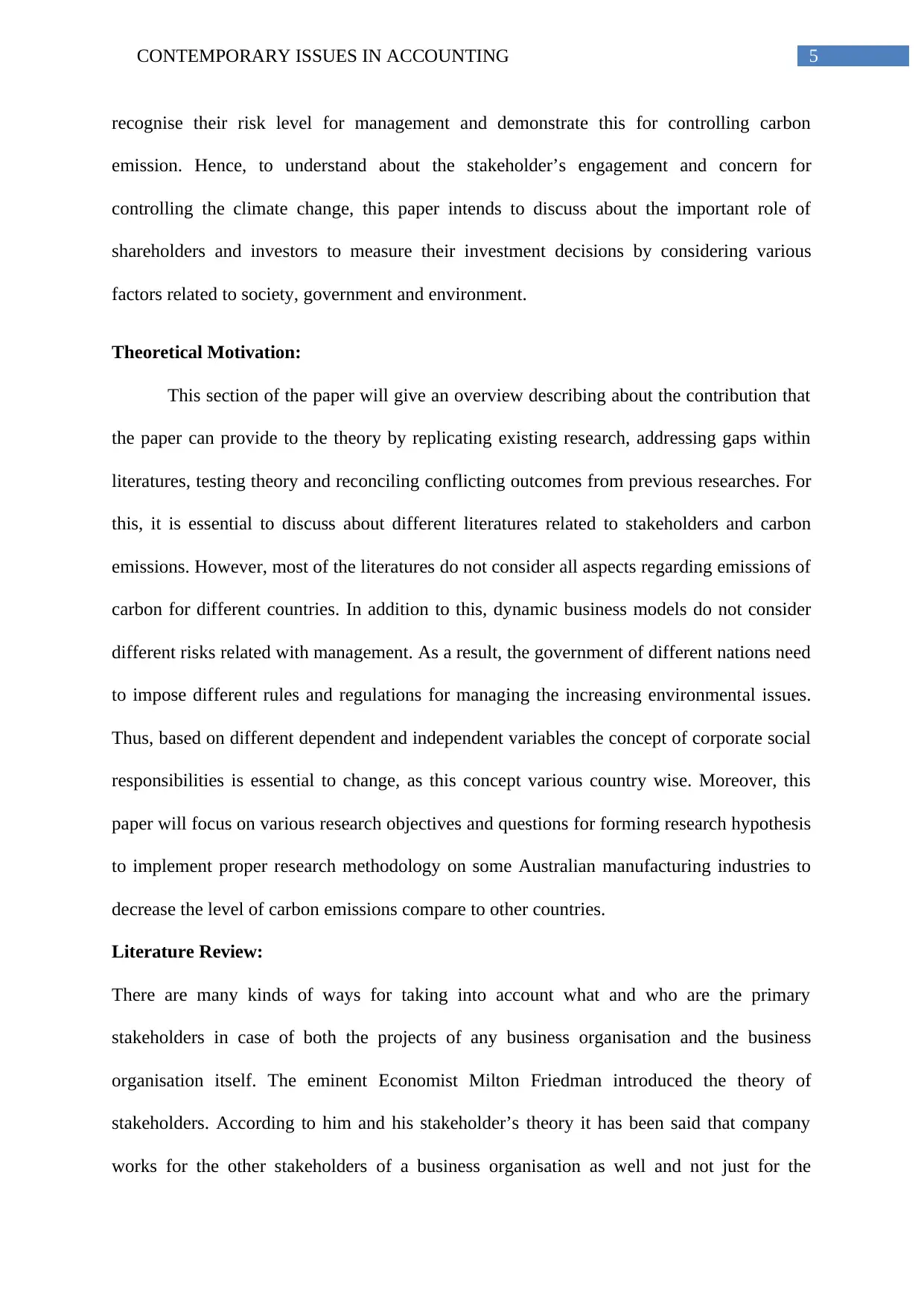
5CONTEMPORARY ISSUES IN ACCOUNTING
recognise their risk level for management and demonstrate this for controlling carbon
emission. Hence, to understand about the stakeholder’s engagement and concern for
controlling the climate change, this paper intends to discuss about the important role of
shareholders and investors to measure their investment decisions by considering various
factors related to society, government and environment.
Theoretical Motivation:
This section of the paper will give an overview describing about the contribution that
the paper can provide to the theory by replicating existing research, addressing gaps within
literatures, testing theory and reconciling conflicting outcomes from previous researches. For
this, it is essential to discuss about different literatures related to stakeholders and carbon
emissions. However, most of the literatures do not consider all aspects regarding emissions of
carbon for different countries. In addition to this, dynamic business models do not consider
different risks related with management. As a result, the government of different nations need
to impose different rules and regulations for managing the increasing environmental issues.
Thus, based on different dependent and independent variables the concept of corporate social
responsibilities is essential to change, as this concept various country wise. Moreover, this
paper will focus on various research objectives and questions for forming research hypothesis
to implement proper research methodology on some Australian manufacturing industries to
decrease the level of carbon emissions compare to other countries.
Literature Review:
There are many kinds of ways for taking into account what and who are the primary
stakeholders in case of both the projects of any business organisation and the business
organisation itself. The eminent Economist Milton Friedman introduced the theory of
stakeholders. According to him and his stakeholder’s theory it has been said that company
works for the other stakeholders of a business organisation as well and not just for the
recognise their risk level for management and demonstrate this for controlling carbon
emission. Hence, to understand about the stakeholder’s engagement and concern for
controlling the climate change, this paper intends to discuss about the important role of
shareholders and investors to measure their investment decisions by considering various
factors related to society, government and environment.
Theoretical Motivation:
This section of the paper will give an overview describing about the contribution that
the paper can provide to the theory by replicating existing research, addressing gaps within
literatures, testing theory and reconciling conflicting outcomes from previous researches. For
this, it is essential to discuss about different literatures related to stakeholders and carbon
emissions. However, most of the literatures do not consider all aspects regarding emissions of
carbon for different countries. In addition to this, dynamic business models do not consider
different risks related with management. As a result, the government of different nations need
to impose different rules and regulations for managing the increasing environmental issues.
Thus, based on different dependent and independent variables the concept of corporate social
responsibilities is essential to change, as this concept various country wise. Moreover, this
paper will focus on various research objectives and questions for forming research hypothesis
to implement proper research methodology on some Australian manufacturing industries to
decrease the level of carbon emissions compare to other countries.
Literature Review:
There are many kinds of ways for taking into account what and who are the primary
stakeholders in case of both the projects of any business organisation and the business
organisation itself. The eminent Economist Milton Friedman introduced the theory of
stakeholders. According to him and his stakeholder’s theory it has been said that company
works for the other stakeholders of a business organisation as well and not just for the
⊘ This is a preview!⊘
Do you want full access?
Subscribe today to unlock all pages.

Trusted by 1+ million students worldwide
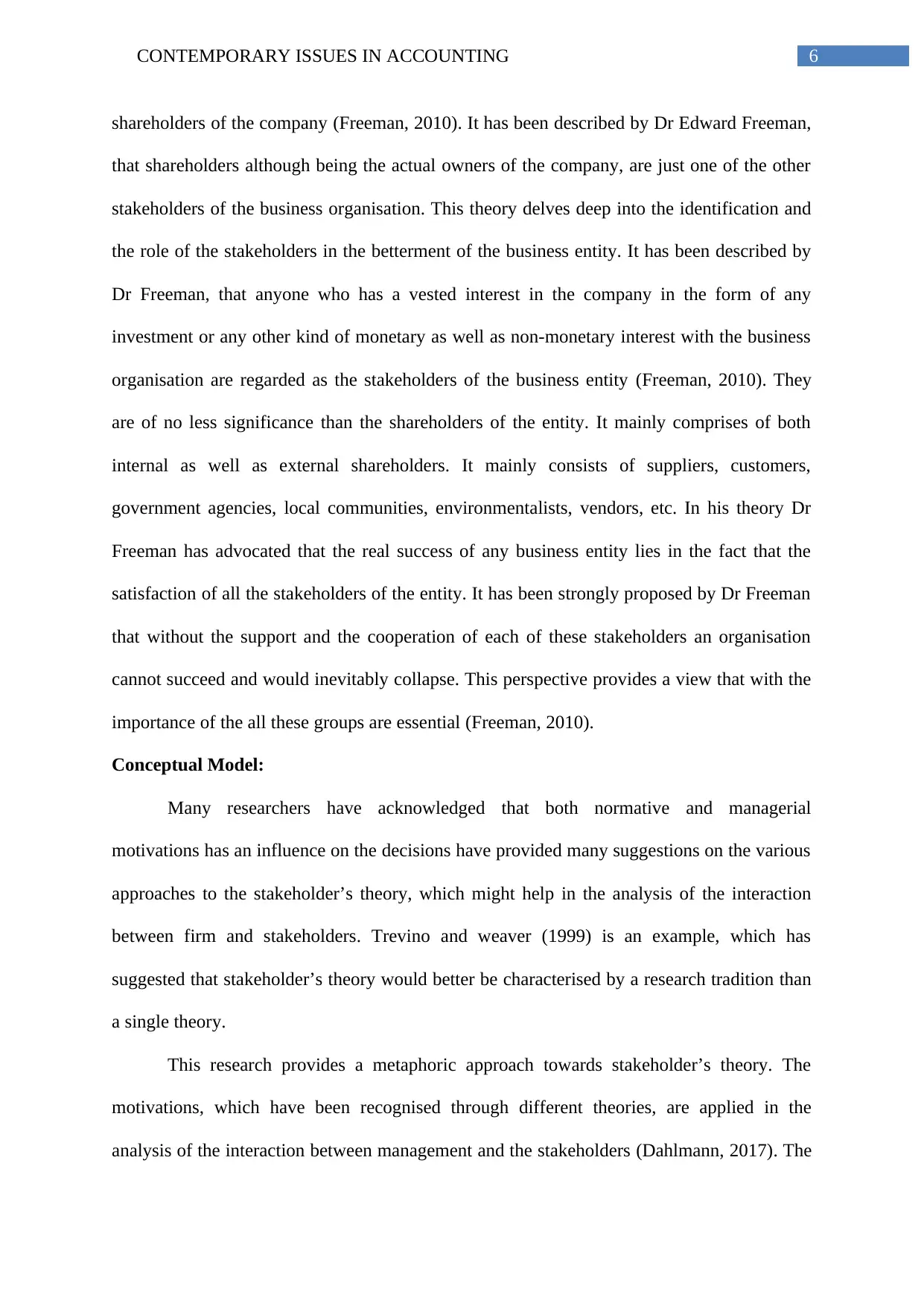
6CONTEMPORARY ISSUES IN ACCOUNTING
shareholders of the company (Freeman, 2010). It has been described by Dr Edward Freeman,
that shareholders although being the actual owners of the company, are just one of the other
stakeholders of the business organisation. This theory delves deep into the identification and
the role of the stakeholders in the betterment of the business entity. It has been described by
Dr Freeman, that anyone who has a vested interest in the company in the form of any
investment or any other kind of monetary as well as non-monetary interest with the business
organisation are regarded as the stakeholders of the business entity (Freeman, 2010). They
are of no less significance than the shareholders of the entity. It mainly comprises of both
internal as well as external shareholders. It mainly consists of suppliers, customers,
government agencies, local communities, environmentalists, vendors, etc. In his theory Dr
Freeman has advocated that the real success of any business entity lies in the fact that the
satisfaction of all the stakeholders of the entity. It has been strongly proposed by Dr Freeman
that without the support and the cooperation of each of these stakeholders an organisation
cannot succeed and would inevitably collapse. This perspective provides a view that with the
importance of the all these groups are essential (Freeman, 2010).
Conceptual Model:
Many researchers have acknowledged that both normative and managerial
motivations has an influence on the decisions have provided many suggestions on the various
approaches to the stakeholder’s theory, which might help in the analysis of the interaction
between firm and stakeholders. Trevino and weaver (1999) is an example, which has
suggested that stakeholder’s theory would better be characterised by a research tradition than
a single theory.
This research provides a metaphoric approach towards stakeholder’s theory. The
motivations, which have been recognised through different theories, are applied in the
analysis of the interaction between management and the stakeholders (Dahlmann, 2017). The
shareholders of the company (Freeman, 2010). It has been described by Dr Edward Freeman,
that shareholders although being the actual owners of the company, are just one of the other
stakeholders of the business organisation. This theory delves deep into the identification and
the role of the stakeholders in the betterment of the business entity. It has been described by
Dr Freeman, that anyone who has a vested interest in the company in the form of any
investment or any other kind of monetary as well as non-monetary interest with the business
organisation are regarded as the stakeholders of the business entity (Freeman, 2010). They
are of no less significance than the shareholders of the entity. It mainly comprises of both
internal as well as external shareholders. It mainly consists of suppliers, customers,
government agencies, local communities, environmentalists, vendors, etc. In his theory Dr
Freeman has advocated that the real success of any business entity lies in the fact that the
satisfaction of all the stakeholders of the entity. It has been strongly proposed by Dr Freeman
that without the support and the cooperation of each of these stakeholders an organisation
cannot succeed and would inevitably collapse. This perspective provides a view that with the
importance of the all these groups are essential (Freeman, 2010).
Conceptual Model:
Many researchers have acknowledged that both normative and managerial
motivations has an influence on the decisions have provided many suggestions on the various
approaches to the stakeholder’s theory, which might help in the analysis of the interaction
between firm and stakeholders. Trevino and weaver (1999) is an example, which has
suggested that stakeholder’s theory would better be characterised by a research tradition than
a single theory.
This research provides a metaphoric approach towards stakeholder’s theory. The
motivations, which have been recognised through different theories, are applied in the
analysis of the interaction between management and the stakeholders (Dahlmann, 2017). The
Paraphrase This Document
Need a fresh take? Get an instant paraphrase of this document with our AI Paraphraser
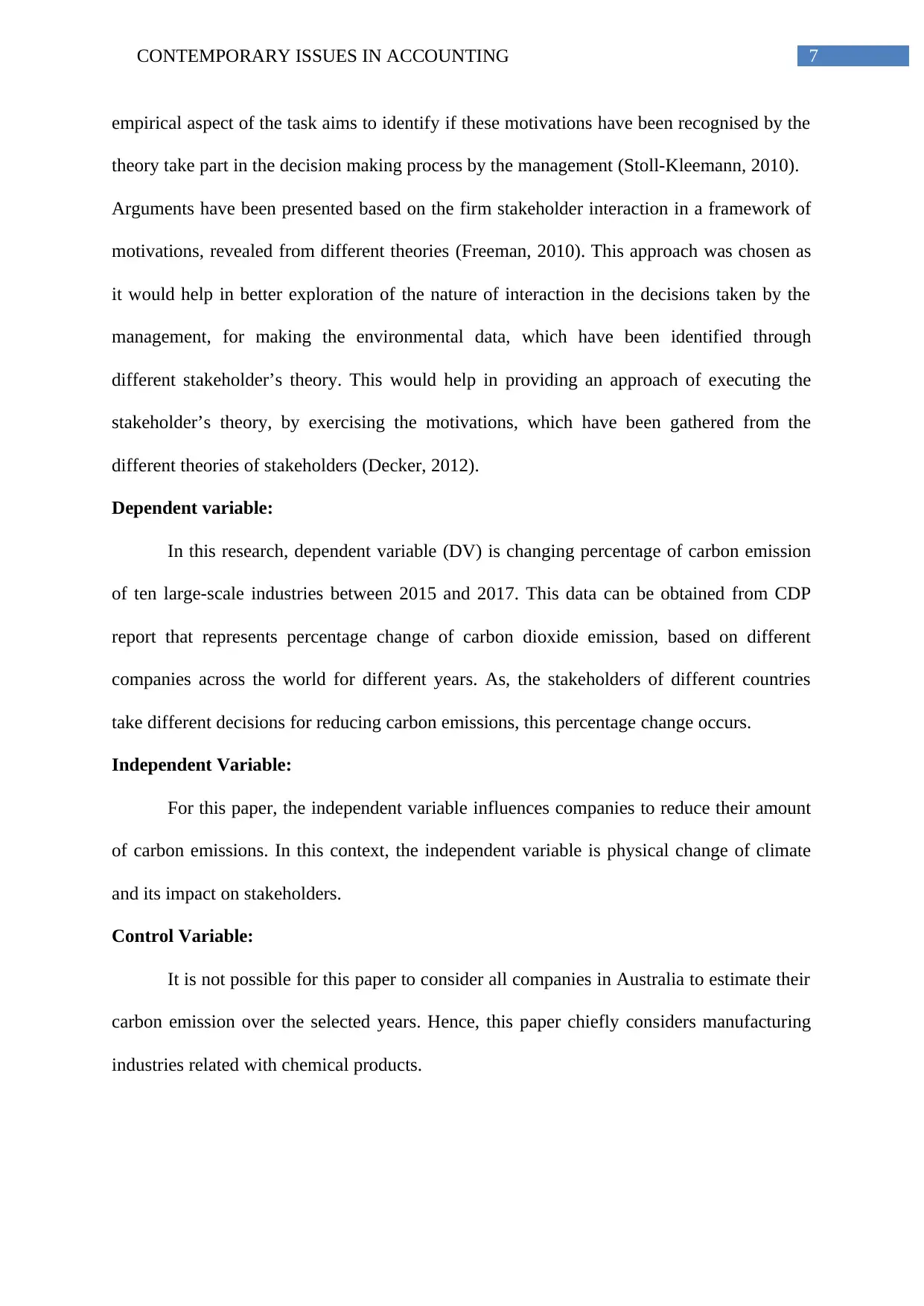
7CONTEMPORARY ISSUES IN ACCOUNTING
empirical aspect of the task aims to identify if these motivations have been recognised by the
theory take part in the decision making process by the management (Stoll-Kleemann, 2010).
Arguments have been presented based on the firm stakeholder interaction in a framework of
motivations, revealed from different theories (Freeman, 2010). This approach was chosen as
it would help in better exploration of the nature of interaction in the decisions taken by the
management, for making the environmental data, which have been identified through
different stakeholder’s theory. This would help in providing an approach of executing the
stakeholder’s theory, by exercising the motivations, which have been gathered from the
different theories of stakeholders (Decker, 2012).
Dependent variable:
In this research, dependent variable (DV) is changing percentage of carbon emission
of ten large-scale industries between 2015 and 2017. This data can be obtained from CDP
report that represents percentage change of carbon dioxide emission, based on different
companies across the world for different years. As, the stakeholders of different countries
take different decisions for reducing carbon emissions, this percentage change occurs.
Independent Variable:
For this paper, the independent variable influences companies to reduce their amount
of carbon emissions. In this context, the independent variable is physical change of climate
and its impact on stakeholders.
Control Variable:
It is not possible for this paper to consider all companies in Australia to estimate their
carbon emission over the selected years. Hence, this paper chiefly considers manufacturing
industries related with chemical products.
empirical aspect of the task aims to identify if these motivations have been recognised by the
theory take part in the decision making process by the management (Stoll-Kleemann, 2010).
Arguments have been presented based on the firm stakeholder interaction in a framework of
motivations, revealed from different theories (Freeman, 2010). This approach was chosen as
it would help in better exploration of the nature of interaction in the decisions taken by the
management, for making the environmental data, which have been identified through
different stakeholder’s theory. This would help in providing an approach of executing the
stakeholder’s theory, by exercising the motivations, which have been gathered from the
different theories of stakeholders (Decker, 2012).
Dependent variable:
In this research, dependent variable (DV) is changing percentage of carbon emission
of ten large-scale industries between 2015 and 2017. This data can be obtained from CDP
report that represents percentage change of carbon dioxide emission, based on different
companies across the world for different years. As, the stakeholders of different countries
take different decisions for reducing carbon emissions, this percentage change occurs.
Independent Variable:
For this paper, the independent variable influences companies to reduce their amount
of carbon emissions. In this context, the independent variable is physical change of climate
and its impact on stakeholders.
Control Variable:
It is not possible for this paper to consider all companies in Australia to estimate their
carbon emission over the selected years. Hence, this paper chiefly considers manufacturing
industries related with chemical products.
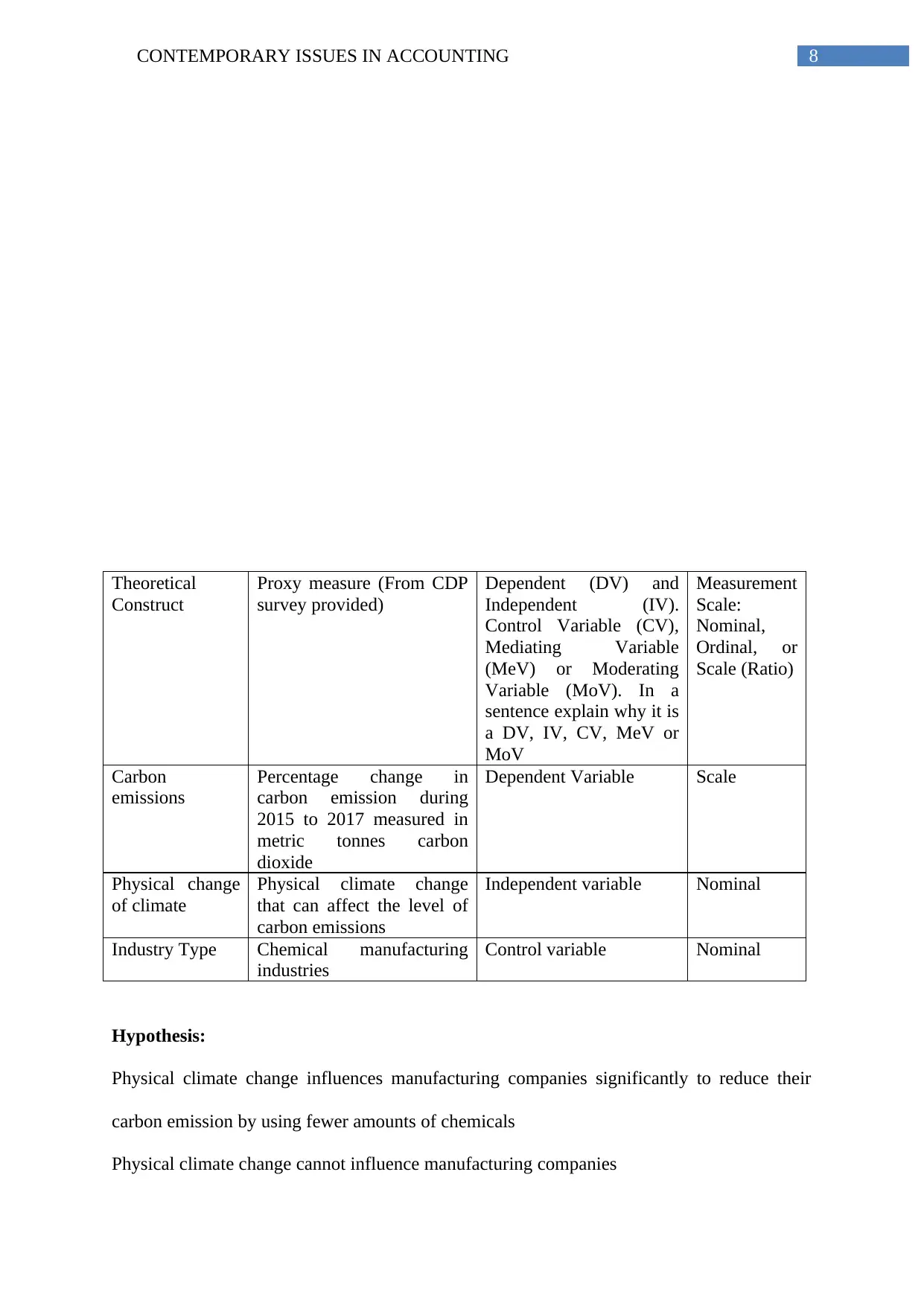
8CONTEMPORARY ISSUES IN ACCOUNTING
Theoretical
Construct
Proxy measure (From CDP
survey provided)
Dependent (DV) and
Independent (IV).
Control Variable (CV),
Mediating Variable
(MeV) or Moderating
Variable (MoV). In a
sentence explain why it is
a DV, IV, CV, MeV or
MoV
Measurement
Scale:
Nominal,
Ordinal, or
Scale (Ratio)
Carbon
emissions
Percentage change in
carbon emission during
2015 to 2017 measured in
metric tonnes carbon
dioxide
Dependent Variable Scale
Physical change
of climate
Physical climate change
that can affect the level of
carbon emissions
Independent variable Nominal
Industry Type Chemical manufacturing
industries
Control variable Nominal
Hypothesis:
Physical climate change influences manufacturing companies significantly to reduce their
carbon emission by using fewer amounts of chemicals
Physical climate change cannot influence manufacturing companies
Independentvariable:Physicalclimatechamge
Theoretical
Construct
Proxy measure (From CDP
survey provided)
Dependent (DV) and
Independent (IV).
Control Variable (CV),
Mediating Variable
(MeV) or Moderating
Variable (MoV). In a
sentence explain why it is
a DV, IV, CV, MeV or
MoV
Measurement
Scale:
Nominal,
Ordinal, or
Scale (Ratio)
Carbon
emissions
Percentage change in
carbon emission during
2015 to 2017 measured in
metric tonnes carbon
dioxide
Dependent Variable Scale
Physical change
of climate
Physical climate change
that can affect the level of
carbon emissions
Independent variable Nominal
Industry Type Chemical manufacturing
industries
Control variable Nominal
Hypothesis:
Physical climate change influences manufacturing companies significantly to reduce their
carbon emission by using fewer amounts of chemicals
Physical climate change cannot influence manufacturing companies
Independentvariable:Physicalclimatechamge
⊘ This is a preview!⊘
Do you want full access?
Subscribe today to unlock all pages.

Trusted by 1+ million students worldwide
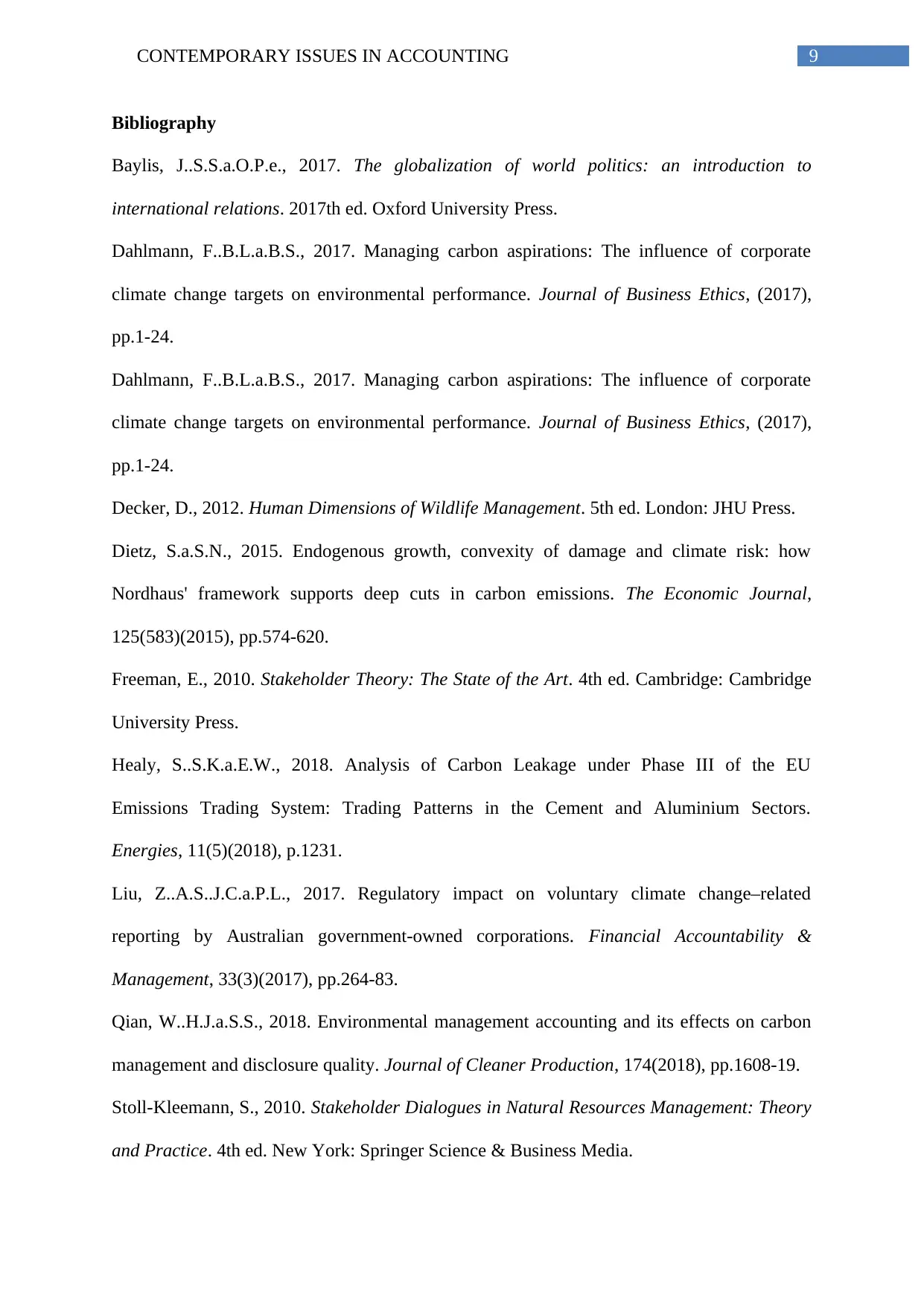
9CONTEMPORARY ISSUES IN ACCOUNTING
Bibliography
Baylis, J..S.S.a.O.P.e., 2017. The globalization of world politics: an introduction to
international relations. 2017th ed. Oxford University Press.
Dahlmann, F..B.L.a.B.S., 2017. Managing carbon aspirations: The influence of corporate
climate change targets on environmental performance. Journal of Business Ethics, (2017),
pp.1-24.
Dahlmann, F..B.L.a.B.S., 2017. Managing carbon aspirations: The influence of corporate
climate change targets on environmental performance. Journal of Business Ethics, (2017),
pp.1-24.
Decker, D., 2012. Human Dimensions of Wildlife Management. 5th ed. London: JHU Press.
Dietz, S.a.S.N., 2015. Endogenous growth, convexity of damage and climate risk: how
Nordhaus' framework supports deep cuts in carbon emissions. The Economic Journal,
125(583)(2015), pp.574-620.
Freeman, E., 2010. Stakeholder Theory: The State of the Art. 4th ed. Cambridge: Cambridge
University Press.
Healy, S..S.K.a.E.W., 2018. Analysis of Carbon Leakage under Phase III of the EU
Emissions Trading System: Trading Patterns in the Cement and Aluminium Sectors.
Energies, 11(5)(2018), p.1231.
Liu, Z..A.S..J.C.a.P.L., 2017. Regulatory impact on voluntary climate change–related
reporting by Australian government‐owned corporations. Financial Accountability &
Management, 33(3)(2017), pp.264-83.
Qian, W..H.J.a.S.S., 2018. Environmental management accounting and its effects on carbon
management and disclosure quality. Journal of Cleaner Production, 174(2018), pp.1608-19.
Stoll-Kleemann, S., 2010. Stakeholder Dialogues in Natural Resources Management: Theory
and Practice. 4th ed. New York: Springer Science & Business Media.
Bibliography
Baylis, J..S.S.a.O.P.e., 2017. The globalization of world politics: an introduction to
international relations. 2017th ed. Oxford University Press.
Dahlmann, F..B.L.a.B.S., 2017. Managing carbon aspirations: The influence of corporate
climate change targets on environmental performance. Journal of Business Ethics, (2017),
pp.1-24.
Dahlmann, F..B.L.a.B.S., 2017. Managing carbon aspirations: The influence of corporate
climate change targets on environmental performance. Journal of Business Ethics, (2017),
pp.1-24.
Decker, D., 2012. Human Dimensions of Wildlife Management. 5th ed. London: JHU Press.
Dietz, S.a.S.N., 2015. Endogenous growth, convexity of damage and climate risk: how
Nordhaus' framework supports deep cuts in carbon emissions. The Economic Journal,
125(583)(2015), pp.574-620.
Freeman, E., 2010. Stakeholder Theory: The State of the Art. 4th ed. Cambridge: Cambridge
University Press.
Healy, S..S.K.a.E.W., 2018. Analysis of Carbon Leakage under Phase III of the EU
Emissions Trading System: Trading Patterns in the Cement and Aluminium Sectors.
Energies, 11(5)(2018), p.1231.
Liu, Z..A.S..J.C.a.P.L., 2017. Regulatory impact on voluntary climate change–related
reporting by Australian government‐owned corporations. Financial Accountability &
Management, 33(3)(2017), pp.264-83.
Qian, W..H.J.a.S.S., 2018. Environmental management accounting and its effects on carbon
management and disclosure quality. Journal of Cleaner Production, 174(2018), pp.1608-19.
Stoll-Kleemann, S., 2010. Stakeholder Dialogues in Natural Resources Management: Theory
and Practice. 4th ed. New York: Springer Science & Business Media.
Paraphrase This Document
Need a fresh take? Get an instant paraphrase of this document with our AI Paraphraser

10CONTEMPORARY ISSUES IN ACCOUNTING
Teh, S.H..W.T..C.A.a.d.B.J., 2017. Hybrid life cycle assessment of greenhouse gas emissions
from cement, concrete and geopolymer concrete in Australia. Journal of cleaner production,
152(2017), pp.312-20.
Teh, S.H..W.T..C.A.a.d.B.J., 2017. Hybrid life cycle assessment of greenhouse gas emissions
from cement, concrete and geopolymer concrete in Australia. Journal of cleaner production,
152(2017), pp.312-20.
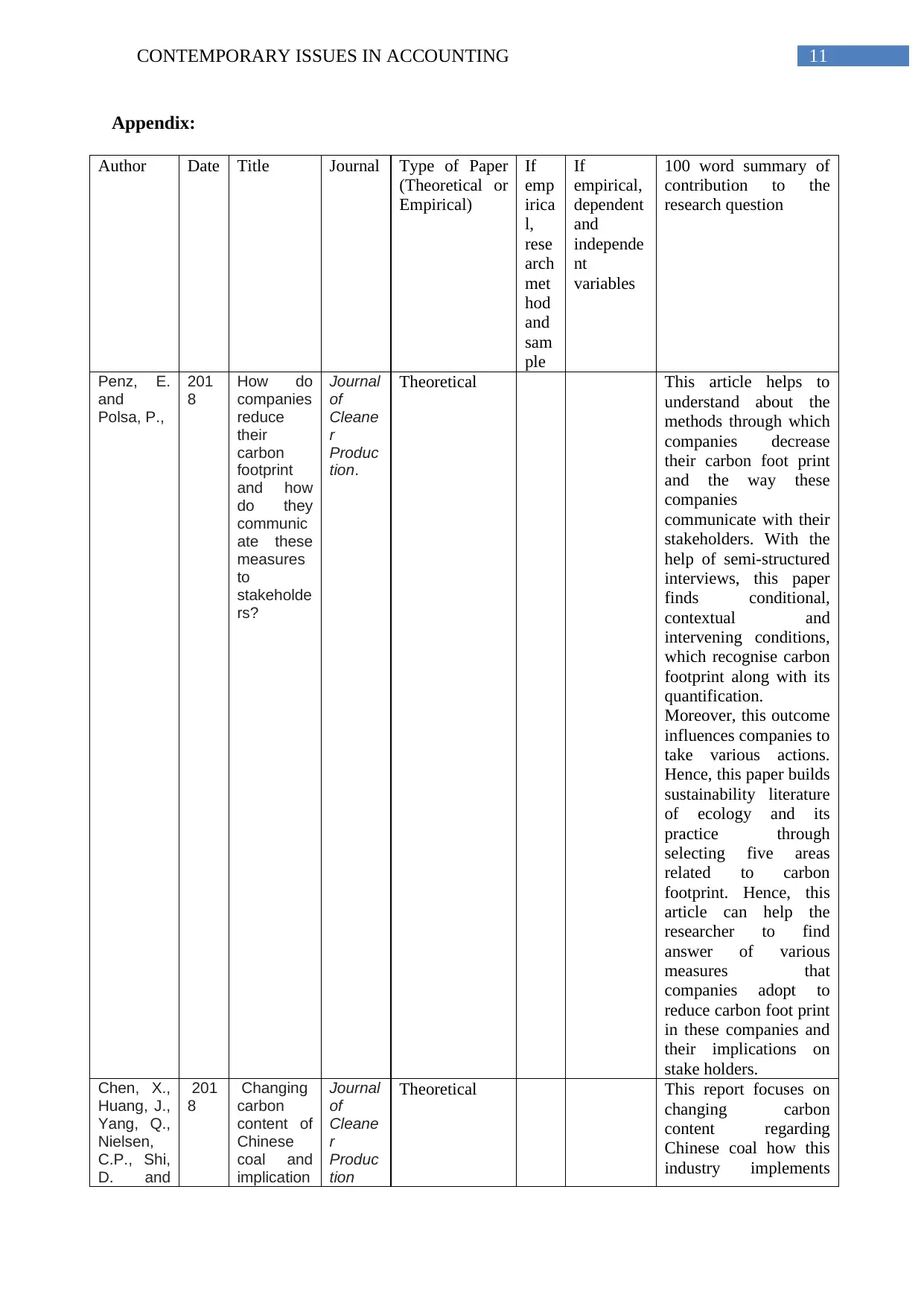
11CONTEMPORARY ISSUES IN ACCOUNTING
Appendix:
Author Date Title Journal Type of Paper
(Theoretical or
Empirical)
If
emp
irica
l,
rese
arch
met
hod
and
sam
ple
If
empirical,
dependent
and
independe
nt
variables
100 word summary of
contribution to the
research question
Penz, E.
and
Polsa, P.,
201
8
How do
companies
reduce
their
carbon
footprint
and how
do they
communic
ate these
measures
to
stakeholde
rs?
Journal
of
Cleane
r
Produc
tion.
Theoretical This article helps to
understand about the
methods through which
companies decrease
their carbon foot print
and the way these
companies
communicate with their
stakeholders. With the
help of semi-structured
interviews, this paper
finds conditional,
contextual and
intervening conditions,
which recognise carbon
footprint along with its
quantification.
Moreover, this outcome
influences companies to
take various actions.
Hence, this paper builds
sustainability literature
of ecology and its
practice through
selecting five areas
related to carbon
footprint. Hence, this
article can help the
researcher to find
answer of various
measures that
companies adopt to
reduce carbon foot print
in these companies and
their implications on
stake holders.
Chen, X.,
Huang, J.,
Yang, Q.,
Nielsen,
C.P., Shi,
D. and
201
8
Changing
carbon
content of
Chinese
coal and
implication
Journal
of
Cleane
r
Produc
tion
Theoretical This report focuses on
changing carbon
content regarding
Chinese coal how this
industry implements
Appendix:
Author Date Title Journal Type of Paper
(Theoretical or
Empirical)
If
emp
irica
l,
rese
arch
met
hod
and
sam
ple
If
empirical,
dependent
and
independe
nt
variables
100 word summary of
contribution to the
research question
Penz, E.
and
Polsa, P.,
201
8
How do
companies
reduce
their
carbon
footprint
and how
do they
communic
ate these
measures
to
stakeholde
rs?
Journal
of
Cleane
r
Produc
tion.
Theoretical This article helps to
understand about the
methods through which
companies decrease
their carbon foot print
and the way these
companies
communicate with their
stakeholders. With the
help of semi-structured
interviews, this paper
finds conditional,
contextual and
intervening conditions,
which recognise carbon
footprint along with its
quantification.
Moreover, this outcome
influences companies to
take various actions.
Hence, this paper builds
sustainability literature
of ecology and its
practice through
selecting five areas
related to carbon
footprint. Hence, this
article can help the
researcher to find
answer of various
measures that
companies adopt to
reduce carbon foot print
in these companies and
their implications on
stake holders.
Chen, X.,
Huang, J.,
Yang, Q.,
Nielsen,
C.P., Shi,
D. and
201
8
Changing
carbon
content of
Chinese
coal and
implication
Journal
of
Cleane
r
Produc
tion
Theoretical This report focuses on
changing carbon
content regarding
Chinese coal how this
industry implements
⊘ This is a preview!⊘
Do you want full access?
Subscribe today to unlock all pages.

Trusted by 1+ million students worldwide
1 out of 15
Related Documents
Your All-in-One AI-Powered Toolkit for Academic Success.
+13062052269
info@desklib.com
Available 24*7 on WhatsApp / Email
![[object Object]](/_next/static/media/star-bottom.7253800d.svg)
Unlock your academic potential
Copyright © 2020–2025 A2Z Services. All Rights Reserved. Developed and managed by ZUCOL.




